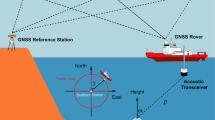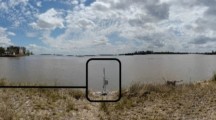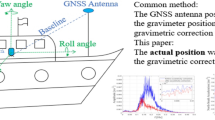Abstract
Periodic bathymetry surveys are essential to provide data to keep navigation charts updated, obtain insights into water body bottom dynamics and processes, and for hydrodynamic modelling. Frequent bathymetry monitoring has become particularly important in a time of climate variability, which may affect hydrodynamics in yet unknown ways. Bathymetric data are, however, often scarce, because surveys are generally time consuming, expensive and complicated. A methodology combining a low-cost single beam sonar with a dual-frequency differential high-precision GNSS (Global Navigation Satellite System) is presented. Sonar depth measurements and GNSS positions were integrated optimizing sonar and GNSS track overlay. As a result, no physical, electronic link between both devices is needed, and precise positions and depths can be obtained without the need to apply the approach based on tide correction, which always introduces some uncertainty. The methodology was successfully tested and validated, with data collected inside an estuary and offshore the estuarine inlet. Vertical accuracies, assessed at track crossings and on locations of known depths, showed mean squared errors of about 20 cm, suggesting that the method is reliable in providing bathymetric data that satisfy the highest standards of the IHO for hydrographic surveys. Validation results suggest that the effects of boat pitch, roll and yaw on depth measurements were negligible in our survey, which covered depths between 0.4 and 24.5 m below MSL and were carried out in quite calm waters, though larger errors occurred in the off-shore zone. The use of an inertial measurement unit (IMU), which can easily be coupled with the GNSS to extract ship motion data and correct depths accordingly, is advised for less optimal survey conditions and deeper waters. The proposed method is accurate, simple and affordable, allowing for more frequent surveys and a better coverage of dynamic shallow water systems such as rivers and estuaries.













Similar content being viewed by others
References
Bandini, F., D. Olesen, J. Jakobsen, C.M.M. Kittel, S. Wang, M. Garcia, and P. Bauer-Gottwein. 2018. Technical note: Bathymetry observations of inland water bodies using a tethered single-beam sonar controlled by an unmanned aerial vehicle. Hydrology and Earth System Sciences 22: 4165.
Bastos, L., A. Bio, A.J.L.S. Pinho, H. Granja, and A.J. Silva. 2012. Dynamics of the Douro estuary barrier sand spit before and after breakwater construction. Estuarine, Coastal and Shelf Science 109: 53–69. https://doi.org/10.1016/J.ECSS.2012.05.017.
Brown, C.J., and P. Blondel. 2009. Developments in the application of multibeam sonar backscatter for seafloor habitat mapping. Applied Acoustics 70: 1242–1247. https://doi.org/10.1016/j.apacoust.2008.08.004.
Catalão, J., and M.J. Sevilla. 2009. Mapping the geoid for Iberia and the Macaronesian Islands using multisensor gravity data and the GRACE geopotential model. Journal of Geodynamics 48(1): 6–15.
DGT – Direção Geral do Território. 2019. Modelo Digital do Terreno (Resolução 1 m) - Zonas Costeiras de Portugal Continental – 2011. SNIG – Sistema Nacional de Informação Geográfica. https://snig.dgterritorio.gov.pt/rndg/srv/por/catalog.search#/metadata/b93228d48b794d4f8c78759409387c8f?tab=responsible ().
Entwistle, N., G. Heritage, and D. Milan. 2018. Recent remote sensing applications for hydro and morphodynamic monitoring and modelling. Earth Surface Processes and Landforms 43: 2283–2291.
Ferretti, R., E. Fumagalli, M. Caccia, and G. Bruzzone. 2015. Seabed classification using a single beam echosounder. OCEANS 2015. Genova, May 18-21: 1–5.
Gao, J. 2009. Bathymetric mapping by means of remote sensing: Methods, accuracy and limitations. Progress in Physical Geography 33: 103–116. https://doi.org/10.1177/0309133309105657.
Heyman, W.D., J.L.B. Ecochard, and F.B. Biasi. 2007. Low-cost bathymetric mapping for tropical marine conservation—A focus on reef fish spawning aggregation sites. Marine Geodesy 30: 37–50.
Horta, J., A. Pacheco, D. Moura, and Ó. Ferreira. 2014. Can recreational Echosounder-Chartplotter systems be used to perform accurate nearshore bathymetric surveys? Ocean Dynamics 64 (11): 1555–1567. https://doi.org/10.1007/s10236-014-0773-y.
IHO. 2008. Standards for hydrographic surveys. 5th ed. Monaco, Monaco: International Hydrographic Bureau.
Kachelreiss, D., M. Wegmann, M. Gollock, and N. Pettorelli. 2014. The application of remote sensing for marine protected area management. Ecological Indicators 36: 169–177.
Kakuta, S., E. Ariyasu, and T. Takeda. 2018. Shallow water bathymetry mapping using Hyperspectral data. IGARSS: 1539–1542.
Kearns, T.A., and J. Breman. 2010. Bathymetry—The art and science of seafloor Modelling for modern applications. ESRIpress: 1–36.
Kulawiak, M., and A. Chybicki. 2018. Application of web-GIS and Geovisual analytics to monitoring of seabed evolution in South Baltic Sea coastal areas. Marine Geodesy 41 (4): 405–426. https://doi.org/10.1080/01490419.2018.1469557.
Kutser, T., M. Parnoja, B. Paavel, and L. Lougas. 2014. Large scale mapping of shallow water benthic habitats and bathymetry in the coastal waters of the Baltic Sea by means of airborne hyperspectral remote sensing. IEEE/OES Baltic International Symposium (BALTIC) 2014: 1.
Lecours, V., M. Dolan, A. Micallef, and V. Lucieer. 2016. A review of marine geomorphometry, the quantitative study of the seafloor. Hydrology and Earth System Sciences 20: 3207–3244. https://doi.org/10.5194/hess-20-3207-2016.
McCaffrey, E.K. 1981. A review of the bathymetric swath survey system. International Hydrographic Review 58: 19–27.
Monteys, X., P. Harris, S. Caloca, and C. Cahalane. 2015. Spatial prediction of coastal bathymetry based on multispectral satellite imagery and multibeam data. Remote Sensing 7: 13782–13806. https://doi.org/10.3390/rs71013782.
O’Hara Murray, R.B., and A.G. Gallego. 2017. Data review and the development of realistic tidal and wave energy scenarios for numerical modelling of Orkney Islands waters, Scotland. Ocean & Coastal Management 147: 6–20. https://doi.org/10.1016/j.ocecoaman.2017.03.011.
Pacheco, A., J.J. Williams, Ó. Ferreira, E. Garel, and S. Reynolds. 2011. Application of sediment transport models to a multiple-inlet system. Estuarine, Coastal and Shelf Science 95: 119–134.
Popescu, G., and D. Iordan. 2018. An overall view of LiDAR and sonar systems used in geomatics applications for hydrology. Scientifc Papers. Series E. Land Reclamation, Earth Observation & Surveying, Environmental Engineering. University of Agronomic Sciences and Veterinary Medicine of Bucharest Faculty of Land Reclamation and Environmental Engineering, Vol. VII, 174–181.
Sánchez-Carnero, N., S. Aceña, D. Rodríguez-Pérez, E. Couñago, P. Fraile, and J. Freire. 2012. Fast and low-cost method for VBES bathymetry generation in coastal areas. Estuarine, Coastal and Shelf Science 114: 175–182. https://doi.org/10.1016/J.ECSS.2012.08.018.
Schimel, A.C.G., D. Ierodiaconou, L. Hulands, and D.M. Kennedy. 2015. Accounting for uncertainty in volumes of seabed change measured with repeat multibeam sonar surveys. Continental Shelf Research 111: 52–68. https://doi.org/10.1016/j.csr.2015.10.019.
Sibson, R. 1981. A Brief Description of Natural Neighbor Interpolation, chapter 2 in: Interpolating Multivariate Data, 21–36. New York: John Wiley & Sons.
Smith, W.H.F., and P. Wessel. 1990. Gridding with continuous curvature spline in tension. Geophysics 55: 293–305.
Strayer, D.L., H.M. Malcom, R.E. Bell, S.M. Carbotte, and F.O. Nitsche. 2006. Using geophysical information to define benthic habitats in a large river. Freshwater Biology 51: 25–38. https://doi.org/10.1111/j.1365-2427.2005.01472.x.
Uchida, K., Y. Miyamoto, S. Takeda, T. Tokai, T. Kakihara, and D. Shiode. 2008. A facile method for mapping bathymetric chart at shallow coastal water by using GPS and fish finder. Journal of Fisheries Engineering 45: 93–100.
Yamasaki, S., and T. Kamai. 2015. A novel method of surveying submerged landslide ruins: Case study of the Nebukawa landslide in Japan. Engineering Geology 186: 28–33.
Yamasaki, S., T. Tomonori, I. Shunsuke, and H. Masahiro. 2017. Acoustic water bottom investigation with a remotely operated watercraft survey system. Progress in Earth and Planetary Science 4 (25): 1–9. https://doi.org/10.1186/s40645-017-0140-y.
Yeu, Y., Y. Jurng-Jae, Y. Hong, and K. Kwang. 2018. Evaluation of the accuracy of bathymetry on the Nearshore coastlines of Western Korea from satellite altimetry, multi-beam, and airborne bathymetric LiDAR. Sensors 18 (9): 2926.
Acknowledgments
We would further like to thank the Direção Geral do Território (Directorate General for Territory) for the use of the Portuguese network of permanent GNSS stations.
Funding
This research was partially supported by the Strategic Funding UID/Multi/04423/2019 through national funds provided by FCT–Foundation for Science and Technology and European Regional Development Fund (ERDF), in the framework of the programme PT2020, and by the by the European Union MarRISK project: Adaptación costera ante el Cambio Climático: conocer los riesgos y aumentar la resiliencia (0262_MarRISK_1_E), through EP INTERREG V A España-Portugal (POCTEP) program.
Author information
Authors and Affiliations
Corresponding author
Additional information
Communicated by Brian B. Barnes
Rights and permissions
About this article
Cite this article
Bio, A., Gonçalves, J.A., Magalhães, A. et al. Combining Low-Cost Sonar and High-Precision Global Navigation Satellite System for Shallow Water Bathymetry. Estuaries and Coasts 45, 1000–1011 (2022). https://doi.org/10.1007/s12237-020-00703-6
Received:
Revised:
Accepted:
Published:
Issue Date:
DOI: https://doi.org/10.1007/s12237-020-00703-6




